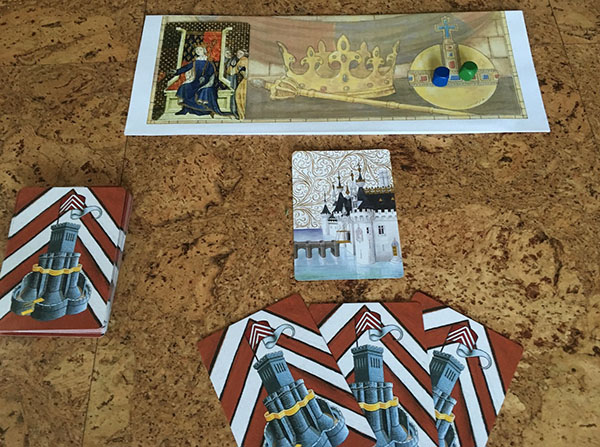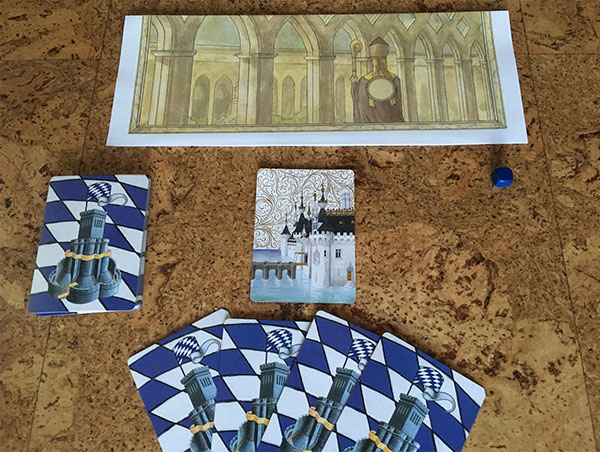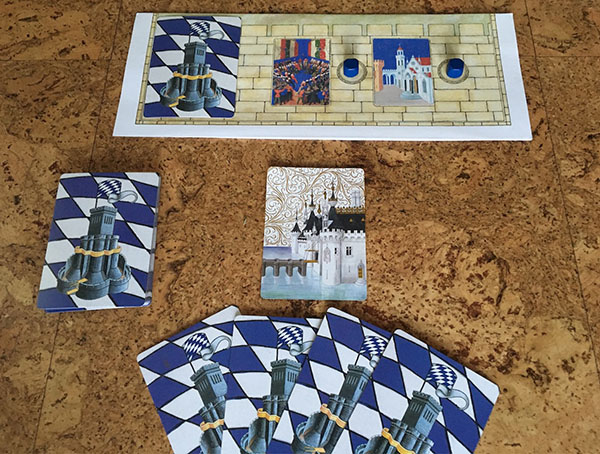
King, Archbishop, and Duke Roles
Start your game as something more than a humble Earl
Earls truly run the lands of the Anglo Saxons. However, there are other great personages who, at least theoretically, are due greater homage and deference.
But with greater rank comes greater constraints and responsibilities. Your vast resources are stretched that much thinner by the demands of your office. Can you wield your unique powers and take advantage of your position to vanquish all challengers… great or small?
King, Archbishop & Dukes
In this variant players have 2 new unique starting roles, that they can use,the King and the Archbishop in addition the role of a Duke is available to all players. There can only be one King or Archbishop in an Ortus Regni game, and there need not be both.
Each role has unique powers and abilities but also some limitations, so that their apparent strength does not guarantee them victory over the Earls of the land.
Players can use any or none of these new roles in a game.
The normal rules of Ortus Regni apply, and the normal victory conditions apply. But these new roles have unique powers and limits.
Selecting roles
Any method players wish to use can be employed for role selection.
The simplest method is to simply go around the table beginning with the starting player - selected by a bag draw - each choosing a role. So that the first player can chose to be either the King, the Archbishop, a Duke, or an Earl. And if either the King or Archbishop is chosen then that role is not available to the other players in the game.
A more complex alternative, if you are using Legacy points is to allow players to spend those points (cubes) to contest a choice for King or Archbishop, thus bidding for them with precious Legacy points. Any number of players can choose to be Earls or Dukes, so there is no competition for those role.
King Role - unique

Do not imagine yourself as Henry VIII, who rode roughshod over so many ancient traditions during his reign. Kingship in the Anglo Saxon era was to be “the first among many” great lords. Your resources are stretched by your great responsibilities, but, as you are recognized as the premier lord and leader of the kingdom strong loyalties adhere to your office.
There can only be one player with the King role in a game.
- Your Earl deck is 22 cards, not the normal 24 card deck. Your opening hand will be 3 cards, not the normal 5 cards.
- You start the game with the King card out. The rules for the Royal Army still apply. The King starts the game with Garrison slots available in the Royal army for Army cards equal to the number of starting players minus 1.
- Your court includes loyal personages from the houses of every important lord in the kingdom. Many of these retainers will not follow their lords against you if swords are drawn. The first time any Duke or Earl Attacks or uses Politics against the King they must immediately give you 1 card from the top of their Deck; without looking at it themselves. This card immediately goes into your Hand, and is playable as if it was your own card. The Archbishop role alone is immune to this penalty.
Attacking the crowned head is a momentous decision, and you must expect serious loyalist defections from your ranks if you embark on that dangerous journey.
However, if the King decides instead to be the one to first Attack or Politic a Duke or Earl then this penalty is removed for the player who is the target of that action.
If the King is the first to initiate hostilities against one of his subjects then that great lord’s retainers rally around their master; who is the victim of Royal bullying!
Using the King’s PnP mini mat
The King’s fold and play mini mat includes a spot for the King card. Which the King starts the game with in play.
On the mini mat there is an Orb (a globus cruciger) included in the Royal regalia. Before the game begins all Earls and Dukes place one cube of their color on this sphere.
This represents their retainers who are at the Royal court, and it indicates that hostilities with the King have not yet begun. When the status of an Earl or Duke changes the colored cube of that player is removed to indicate that change. This happens when the first Attack or Politics occurs between that Earl or Duke and the King, whether initiated by either the King or his subjects.
Archbishop Role - unique

As the formal head of the clerical establishment the Archbishop is uniquely hampered in a world where status and power is earned with spear points, axes, and blades. However, the church is a force to be reckoned with. Loyalty to, and fear of the powers of, the clerisy permeate all strata of society.
There can only be one player with the Archbishop role in a game.
- Your Earl deck is 22 cards, not the normal 24 card deck. Your opening hand will be 4 cards, not the normal 5 cards.
- You possess the ability to place yourself in Canterbury as leader of the Church. When you are in Canterbury you have special powers, but are also vulnerable.
Before you draw a card to end your turn, you can place a cube of your color out to indicate that you are in Canterbury. This is a Free Action. But this does not instantly grant you those powers on that turn. You choose to enter Canterbury at the end of your turn, and it only applies going forward around the table and not during the turn that you made that choice. You may also choose to leave Canterbury, and remove your cube, on your turn.
If you are in Canterbury the following powers apply:
- Canterbury operates like a Cathedral, but it is the premier Cathedral of the land. When you are in Canterbury you have the Church Decides battle card power; even if the Cathedral card is out and owned by another player.
- When you are in Canterbury there is a Cathedral on the table, and other players cannot Bequeath unless they possess a Church (or the Cathedral card, which in this case operates like a Church instead).
- When you are in Canterbury you also have the Monastery special power. As an Action on your turn you can force a player to reveal their Hand to the table. Note that you must start your turn in Canterbury to have this Action available to you, i.e. you must have placed yourself there at the end of your previous turn.
If you are in Canterbury you are also vulnerable:
When you are in Canterbury the other players can take advantage of your location. Your cube in Canterbury can be Attacked! And you are outside of your Tower wall! Opponents can target their Attack at you in Canterbury.
If 1 point of damage reaches you… then you are captured and must offer 1 Palace, Castle or Property as Ransom to survive. When this happens your cube is also removed from Canterbury, and you lose its powers until you place yourself there again.
- You can only install Monks and a Prince card in your Castles or Palaces as Lords. Vassals and Champions cannot be made Lords if you are the Archbishop, as that is the purview of the secular nobility.
Think of your Prince Lord as your protege, or a distant relation, whom you and your family are grooming to continue your legacy and take the highest position in the clerisy.
- All your Monk Lords (your Abbots) are immune to the Treachery card. They cannot be assassinated with Treachery. Your Prince Lord however is stillvulnerable to Treachery.
Using the Archbishop’s PnP mini mat
The Archbishop’s fold and play mini mat depicts the cloisters of the Canterbury Cathedral monastery. There is a circle, for a cube of your color, on the back of the Archbishop. When you chose to place yourself in Canterbury simply place a cube here, and set it aside when you are absent.
Duke Role

Great Dukes hold sway over vast Feudal lands, and are Peers of the Realm, almost equals to the King. Unfortunately, much of a Duke’s holdings are spread widely throughout the Kingdom. A Duke’s position imposes costs and responsibilities that Earls do not concern themselves with. But a Duke’s holdings and their network of powerful friends also provides some strength in depth.
Any number of players can choose to start as Dukes, instead of Earls. This role is an alternative starting condition.
- Your Earl deck is 22 cards, not the normal 24 card deck. Your opening hand will be 4 cards, not the normal 5 cards.
- You start the game with a permanent Tower card out. This special Tower can never be removed. But it is always the last Tower to receive damage when your Towers are Attacked, i.e. any other Towers you have placed are removed first when assigning damage to Towers.
Your ancient holdings not only have well built defenses, but are widely spread and harder to reach and conquer.
- You start the game with 2 resources that may be used during gameplay; an Allies card and a Church card. Each of these assets may be used once, and are then spent. Each of these “cards” is an asset that can be spent whenever needed. The Duke’s mini mat includes these cards. These two assets work exactly like the similar card assets featured on our Inheritance variant mat.
You can spend this Allies card to defend yourself against a political attack.
If you choose to spend the Church card asset it plays as if it was a Church property in your Earldom, but only for that moment. However, this temporary Church cannot be used in Battle damage resolution (i.e. assigned a damage point in a Raid) or Intrigues (i.e. offered as one property stolen).
You can spend the Church card to allow yourself to Bequeath, even when the Cathedral is owned by another player. You can also spend it to try and direct a Church Decides Battle Result card. In the rare case that you have a Monk Lord (an Abbot) in a Fief, you can also spend this Church to immediately allow yourself to use the Monastery special Action and make another Earl reveal their Hand.
Using the Duke’s PnP mini mat
The Duke’s fold and play mini mat includes a spot for your permanent Tower. Before the game begins choose a card from your tray to permanently place there; note that this card will never enter your discard pile.
This mini mat also has an Allies card and a Church card painted on it, with cube circles to indicate if that asset has been spent or not. Before the game begins place a cube of your color in each circle.